__________ occurs when a single gene affects the phenotype of many characters in an individual.
- Polygenic inheritance
- Epistasis
- Codominance
- A pleiotropic effect
- Incomplete dominance
A pleiotropic effect
Ex.
A pleiotropic effect occurs when a single gene affects the phenotype of many characters in an individual.
In Mendelian inheritance, each gene affects only one phenotypic character. Most genes, however, have multiple phenotypic effects, a property called pleiotropy (from the Greek pleion, more). In humans, for example, pleiotropic alleles are responsible for the multiple symptoms associated with certain hereditary diseases, such as cystic fibrosis and sickle-cell disease.
“Epistasis” is incorrect because epistasis is a type of gene interaction in which the phenotype expression of one gene alters that of another, independently inherited gene. “Polygenic inheritance” is incorrect because polygenic inheritance is the additive effect of two or more genes on a single phenotype character. “Codominance” is incorrect because both alleles would be present. “Incomplete dominance” is incorrect because this would produce offspring with phenotypes intermediate between those of the two parental types.
The term “true-breeding plants” means __________.
- that Mendel obtained all of his information from true-breeding plants because they have the strongest character
- that pea plants will produce plants that have a different trait of a particular character
- that self-pollinating plants will always produce the same trait of a particular character
- that pea plants will breed only with other pea plants
- that pea plants choose with whom they mate
that self-pollinating plants will always produce the same trait of a particular character
Ex.
The term “true-breeding plants” means that self-pollinating plants will always produce the same trait of a particular character.
Mendel chose to track only those characters that occurred in two distinct, alternative forms, such as purple or white flower color. He also made sure that he started his experiments with varieties that, over many generations of self-pollination, had produced only the same variety as the parent plant. Such plants are said to be true-breeding. For example, a plant with purple flowers is true-breeding if the seeds produced by self-pollination in successive generations all give rise to plants that have purple flowers.
“That pea plants will breed only with other pea plants” is incorrect because pea plants usually self-pollinate. “That pea plants will produce plants that have a different trait of a particular character” is incorrect because plants will produce only the same variety as the parent plant. “That pea plants choose with whom they mate” is incorrect because pea plants do not make sexual selections, whereas some animal species choose with whom they will mate. “That Mendel obtained all of his information from true-breeding plants because they have the strongest character” is incorrect because Mendel used true-breeding plants for his cross-pollination experiments.
Color in squash is controlled by epistatic interactions in which color is recessive to no color. At the first locus white squash (W) is dominant to colored squash (w). At the second locus yellow (Y) is dominant to green (y). What is the phenotype of a squash with the genotype wwYy?
- Green with yellow stripes
- Yellow
- Green
- White with yellow stripes
- White
Yellow
Ex.
Color in squash is controlled by epistatic interactions in which color is recessive to no color. At the first locus white squash (W) is dominant to colored squash (w). At the second locus yellow (Y) is dominant to green (y). The phenotype of a squash with the genotype wwYy is yellow.
In epistasis (from the Greek for “standing upon”), the phenotypic expression of a gene at one locus alters that of a gene at a second locus. The genotype at the first locus is homozygous recessive for colored squash, and the genotype at the second locus is heterozygous. Yellow is dominant. Therefore, the squash is yellow. The genotype is homozygous recessive for colored squash so it won’t be white. This is a system of dominant/recessive alleles. There is no incomplete dominance or codominance so the squash wouldn’t have multiple colors or patterns. The genotype is heterozygous for yellow, so the dominant yellow color will be expressed.
If an organism that is homozygous dominant is crossed with a heterozygote for that trait, the offspring will be __________.
- all homozygous dominant
- all homozygous recessive
- all of the dominant phenotype
- present in a 9:3:3:1 ratio
- 1/4 of the recessive phenotype
all of the dominant phenotype
Ex.
If an organism that is homozygous dominant is crossed with a heterozygote for that trait, the offspring will be all of the dominant phenotype.
If the two alleles at a locus for a particular character differ, then one, the dominant allele, determines the organism’s appearance; the other, the recessive allele, has no noticeable effect on the organism’s appearance. The offspring of an AA x Aa cross are either AA or Aa. All will express the dominant phenotype. The offspring of a homozygous dominant parent cannot have a recessive phenotype. Because one of the parents has a recessive allele, all of the offspring cannot be homozygous dominant. The offspring of a homozygous dominant parent cannot have a recessive phenotype. A 9:3:3:1 ratio is true of the F2 generation of a dihybrid cross with two true-breeding individuals, not those of a monohybrid cross.
Which choice below is a basic difference between Mendel's particulate hypothesis and the hypothesis of blending inheritance?
- The blending inheritance hypothesis, but not the particulate hypothesis, maintained that the two alleles at any given locus are always different.
- The blending inheritance hypothesis, but not the particulate hypothesis, maintained that after a mating, the genetic material provided by each of the two parents is mixed in the offspring, losing its individual identity.
- All of the listed responses are correct.
- The blending inheritance hypothesis, but not the particulate hypothesis, maintained that the traits governed by genes in the egg are different from the traits governed by genes in the sperm.
- The blending inheritance hypothesis, but not the particulate hypothesis, maintained that mutation is the major source of new gene combinations.
The blending inheritance hypothesis, but not the particulate hypothesis, maintained that after a mating, the genetic material provided by each of the two parents is mixed in the offspring, losing its individual identity.
Ex.
A basic difference between Mendel's particulate hypothesis and the hypothesis of blending inheritance is the blending inheritance hypothesis, but not the particulate hypothesis, maintained that after a mating, the genetic material provided by each of the two parents is mixed in the offspring, losing its individual identity.
The explanation of heredity most widely in favor during the 1800s was the “blending” hypothesis, the idea that genetic material contributed by the two parents mixes in a manner analogous to the way blue and yellow paints blend to make green. This hypothesis predicts that over many generations, a freely mating population will give rise to a uniform population of individuals. However, our everyday observations and the results of breeding experiments with animals and plants contradict that prediction. The blending hypothesis also fails to explain other phenomena of inheritance, such as traits reappearing after skipping a generation. An alternative to the blending model is a “particulate” hypothesis of inheritance: the gene idea. According to this model, parents pass on discrete heritable units—genes—that retain their separate identities in offspring. An organism’s collection of genes is more like a deck of cards than a pail of paint. Like playing cards, genes can be shuffled and passed along, generation after generation, in undiluted form. Modern genetics had its genesis in an abbey garden, where a monk named Gregor Mendel documented a particulate mechanism for inheritance. Neither hypothesis speculated on the origin of different alleles. However, mutation is the ultimate source of all genetic variation. The blending inheritance hypothesis did not specifically address alleles and loci, or whether alleles were the same or different; rather, it generally dealt with what happens to the genetic material upon mating. With the exception of sex-linked genes, males and females both contribute genes that affect the same characters.
If a heterozygous plant is allowed to self-pollinate, what proportion of the offspring will also be heterozygous?
- 13
- All of them
- 1/2
- 23
- 14
1/2
Ex.
If a heterozygous plant is allowed to self-pollinate, the proportion of the offspring that will also be heterozygous is 1/2.
The law of segregation states that the two alleles for a heritable character segregate (separate from each other) during gamete formation and end up in different gametes. Thus, an egg or a sperm gets only one of the two alleles that are present in the somatic cells of the organism making the gamete. For the flower-color character in Mendel’s peas, the law of segregation predicts that the two different alleles present in an F1 individual will segregate into gametes such that half the gametes will have the purple-flower allele and half will have the white-flower allele. During self-pollination, gametes of each class unite randomly. An egg with a purple-flower allele has an equal chance of being fertilized by a sperm with a purple-flower allele or one with a white-flower allele. Because the same is true for an egg with a white-flower allele, there are four equally likely combinations of sperm and egg. In the case listed here, one-quarter of the offspring will be homozygous for the dominant allele, one-quarter will be homozygous for the recessive allele, and the remaining half will be heterozygous.
In addition to the ABO system, humans have other blood groups, including the MN system. Individuals who have alleles for both M and N show __________ for the M and N red blood cell surface antigens.
- complete dominance
- codominance
- epistasis
- polygenic inheritance
- incomplete dominance
codominance
Ex.
In addition to the ABO system, humans have other blood groups, including the MN system. Individuals who have alleles for both M and N show codominance for the M and N red blood cell surface antigens.
A variation in dominance relationships between alleles is called codominance; in this variation, the two alleles each affect the phenotype in separate, distinguishable ways. For example, the human MN blood group is determined by codominant alleles for two specific molecules located on the surface of red blood cells, the M and the N molecules. A single gene locus, at which two allelic variations are possible, determines the phenotype of this blood group. Individuals homozygous for the M allele (MM) have red blood cells with only M molecules; individuals homozygous for the N allele (NN) have red blood cells with only N molecules. But both M and N molecules are present on the red blood cells of individuals heterozygous for the M and N alleles (MN). Note that the MN phenotype is not intermediate between the M and N phenotypes, a fact that distinguishes codominance from incomplete dominance. Rather, both M and N phenotypes are exhibited by heterozygotes since both molecules are present.
“Incomplete dominance” is incorrect because the MN blood groups show codominance and are both present on the red blood cells of individuals heterozygous for the M and N alleles (MN). “Complete dominance” is incorrect because the MN blood groups show codominance and are both present on the red blood cells of individuals heterozygous for the M and N alleles (MN). “Epistasis” is incorrect because epistasis is a type of gene interaction in which the phenotype expression of one gene alters that of another, independently inherited gene. “Polygenic inheritance” is incorrect because polygenic inheritance is the additive effect of two or more genes on a single phenotype character.
In people with sickle-cell disease, red blood cells break down, clump, and clog the blood vessels. The blood vessels and the broken cells accumulate in the spleen. Among other things this leads to physical weakness, heart failure, joint pain, and brain damage. Such a suite of symptoms can be explained by __________.
- an epistatic interaction between the sickle-cell allele and a proteolytic enzyme gene
- a bacterial infection interacting with the sickle-cell allele
- side effects of the drugs used to cure sickle-cell disease
- the polygenic nature of sickle-cell disease
- the pleiotropic effects of the sickle-cell allele
the pleiotropic effects of the sickle-cell allele
Ex.
In people with sickle-cell disease, red blood cells break down, clump, and clog the blood vessels. The blood vessels and the broken cells accumulate in the spleen. Among other things this leads to physical weakness, heart failure, joint pain, and brain damage. Such a suite of symptoms can be explained by the pleiotropic effects of the sickle-cell allele.
Sickle-cell disease is caused by the substitution of a single amino acid in the hemoglobin protein of red blood cells; in homozygous individuals, all hemoglobin is of the sickle-cell (abnormal) variety. When the oxygen content of an affected individual’s blood is low (at high altitudes or under physical stress, for instance), the sickle-cell hemoglobin molecules aggregate into long rods that deform the red cells into a sickle shape. Sickled cells may clump and clog small blood vessels, often leading to other symptoms throughout the body, including physical weakness, pain, organ damage, and even paralysis.
Pleiotropy refers to the ability of certain genes to affect multiple characters, which sickle-cell disease exhibits. Sickle-cell disease is not polygenic. The sickle-cell allele is sufficient to cause these symptoms without interacting with another gene. The sickle-cell allele is sufficient to cause these symptoms without any other interactions. Drugs do not create this symptom complex.
Mendel studied __________, heritable features that vary among individuals; each variant is called a __________.
- None of the listed responses is correct.
- flowers; character
- traits; character
- characters; trait
- characters; flower
characters; trait
Ex.
Mendel studied characters, heritable features that vary among individuals; each variant is called a trait.
Mendel probably chose to work with peas because there are many varieties of peas. For example, one variety has purple flowers, while another variety has white flowers. A heritable feature that varies among individuals, such as flower color, is called a character. Each variant for a character, such as purple or white color for flowers, is called a trait.
“Traits; character” is incorrect because traits are variations of a character, not the other way around. “Flowers; character” is incorrect because flowers are characters. “Characters; flower” is incorrect because flowers are characters, but different flower colors are traits because they are features of a character.
A red bull is crossed with a white cow and all of the offspring are roan, an intermediate color that is caused by the presence of both red and white hairs. This is an example of genes that are __________.
- polygenic
- codominant
- epistatic
- completely dominant
- nonhomologous
codominant
Ex.
A red bull is crossed with a white cow and all of the offspring are roan, an intermediate color that is caused by the presence of both red and white hairs. This is an example of genes that are codominant.
Alleles can show different degrees of dominance and recessiveness in relation to each other. In Mendel’s classic pea crosses, the F1 offspring always looked like one of the two parental varieties because one allele in a pair showed complete dominance over the other. In such situations, the phenotypes of the heterozygote and the dominant homozygote are indistinguishable. Another variation on dominance relationships between alleles is called codominance; in this variation, the two alleles each affect the phenotype in separate, distinguishable ways. Roan is a codominant trait and caused by the presence of both red and white hairs. The red and white alleles are present at equivalent loci on homologous chromosomes. There is no indication that a second gene pair is involved, so epistasis is not an option, nor would the trait be polygenic.
Achondroplasia, a type of dwarfism, and Huntington’s disease are examples of __________, with the exception that the Huntington’s allele is __________.
- recessive inherited disorders; nonlethal
- incomplete dominance; lethal
- dominant inherited disorders; nonlethal
- dominant inherited disorders; lethal
- recessive inherited disorders; lethal
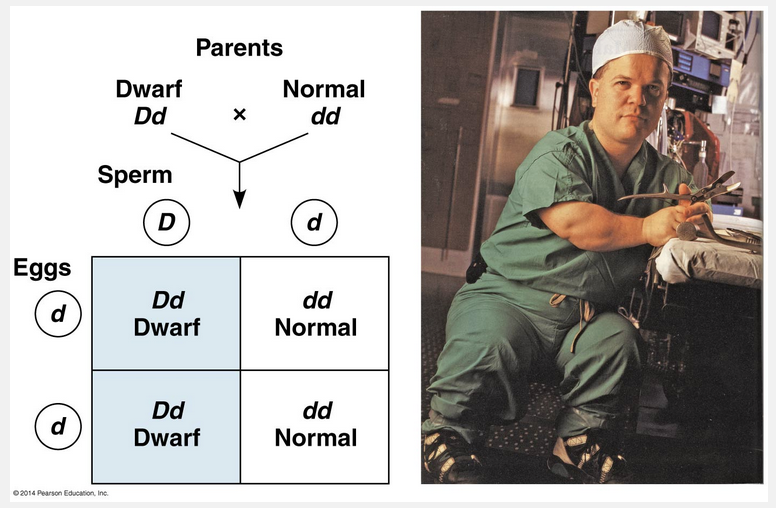
dominant inherited disorders; lethal
Ex.
Achondroplasia, a type of dwarfism, and Huntington’s disease are examples of dominant inherited disorders, with the exception that the Huntington’s allele is lethal.
Although many harmful alleles are recessive, a number of human disorders are due to dominant alleles. One such example is achondroplasia, a form of dwarfism that occurs in one out of every 25,000 people. Heterozygous individuals have the dwarf phenotype. Therefore, all people who are not achondroplastic dwarfs—99.99% of the population—are homozygous for the recessive allele. Like the presence of extra fingers or toes mentioned earlier, achondroplasia is a trait for which the recessive allele is much more prevalent than the corresponding dominant allele.
Dominant alleles that cause lethal diseases are much less common than recessive alleles that have lethal effects. All lethal alleles arise by mutations (changes to the DNA) in cells that produce sperm or eggs; presumably, such mutations are equally likely to be recessive or dominant. A lethal recessive allele can be passed from one generation to the next by heterozygous carriers because the carriers themselves have normal phenotypes. A lethal dominant allele, however, often causes the death of afflicted individuals before they can mature and reproduce, and thus the allele is not passed on to future generations. In cases of late-onset diseases, however, a lethal dominant allele may be passed on. If symptoms first appear after reproductive age, the individual may already have transmitted the allele to his or her children. For example, a degenerative disease of the nervous system called Huntington’s disease is caused by a lethal dominant allele that has no obvious phenotypic effect until the individual is about 35 to 45 years old. Once the deterioration of the nervous system begins, it is irreversible and inevitably fatal. As with other dominant traits, a child born to a parent with the Huntington’s disease allele has a 50% chance of inheriting the allele and the disorder. In the United States, this disease afflicts about one in 10,000 people.
“Dominant inherited disorders; nonlethal” is incorrect because Huntington’s disease is lethal. “Recessive inherited disorders; lethal” is incorrect because both of these genetic disorders are caused by a dominant allele. “Recessive inherited disorders; nonlethal” is incorrect because both of these genetic disorders are caused by a dominant allele and Huntington’s is always lethal. “Incomplete dominance; lethal” is incorrect because both of these genetic disorders are caused by a dominant allele.
Human blood groups are governed by three alleles, IA, IB, and i. IA and IB are codominant and i is recessive to both. A man who has type B blood and a woman who has type A blood could have children of which of the following phenotypes?
- A, B, AB, or O
- A or B only
- AB or O
- A, B, or O
- AB only
A, B, AB, or O
Ex.
Human blood groups are governed by three alleles, IA, IB, and i. IA and IB are codominant and i is recessive to both. A man who has type B blood and a woman who has type A blood could have children of A, B, AB, or O.
Only two alleles exist for the pea characters that Mendel studied, but most genes exist in more than two allelic forms. The ABO blood groups in humans, for instance, are determined by three alleles of a single gene: IA, IB, and i. A person’s blood group (phenotype) may be one of four types: A, B, AB, or O. These letters refer to two carbohydrates—A and B—that may be found on the surface of red blood cells. A person’s blood cells may have carbohydrate A (type A blood), carbohydrate B (type B), both (type AB), or neither (type O). The genotype of the man with type B blood could be IBIB or IBi, so his gametes could be IB or i. The genotype of the woman with type A blood could be IAIA or IAi, so her gametes could be IA or i.
Pea plants are tall if they have the genotype TT or Tt, and they are short if they have genotype tt. A tall plant is mated with a short plant. Which outcome below would indicate that the tall parent plant was heterozygous?
- All of the offspring are tall.
- There is not enough information to answer the question.
- The ratio of tall offspring to short offspring is 1:1.
- All of the offspring are short.
- The ratio of tall offspring to short offspring is 3:1.
The ratio of tall offspring to short offspring is 1:1.
Ex.
Pea plants are tall if they have the genotype TT or Tt, and they are short if they have genotype tt. A tall plant is mated with a short plant. The ratio of tall offspring to short offspring is 1:1 . This would indicate that the tall parent plant was heterozygous.
Suppose we have a “mystery” pea plant that has purple flowers. We cannot tell from its flower color if this plant is homozygous (PP) or heterozygous (Pp) because both genotypes result in the same purple phenotype. To determine the genotype, we can cross this plant with a white-flowered plant (pp), which will make only gametes with the recessive allele (p). The allele in the gamete contributed by the mystery plant will therefore determine the appearance of the offspring. If all the offspring of the cross have purple flowers, then the purple-flowered mystery plant must be homozygous for the dominant allele, because a PP x pp cross produces all Pp offspring. But if both the purple and the white phenotypes appear among the offspring, then the purple-flowered parent must be heterozygous. The offspring of a Pp x pp cross will be expected to have a 1:1 phenotypic ratio. Breeding an organism of unknown genotype with a recessive homozygote is called a testcross because it can reveal the genotype of that organism. In this case, if half of the offspring were heterozygous and the other half were homozygous recessive, it would indicate that the genotype of the tall pea plant is heterozygous, Tt. All of the offspring being short is possible, but unlikely. If one parent has the genotype Tt and the other parent has the genotype tt, about half of the offspring will be tall. If all the offspring were tall, this would indicate that the tall parent was homozygous. If the ratio of tall to short offspring was 3:1, both parents were heterozygous.
If a plant variety is true-breeding for a dominant trait, then __________.
- the plant is heterozygous for the trait
- if the plant were crossed with a heterozygote, one-half of the progeny would show the dominant trait, and one-half would show the recessive trait
- if the plant were allowed to self-pollinate, all of the progeny would have the dominant trait
- the variety is unable to mutate
- if the plant were allowed to self-pollinate, the dominant and recessive traits would consistently appear in a 3:1 ratio among the progeny
if the plant were allowed to self-pollinate, all of the progeny would have the dominant trait
Ex.
If a plant variety is true-breeding for a dominant trait, then if the plant were allowed to self-pollinate, all of the progeny would have the dominant trait.
Around 1857, Mendel began breeding garden peas in the abbey garden to study inheritance. Although the question of heredity had long been a focus of curiosity at the monastery, Mendel’s fresh approach allowed him to deduce principles that had remained elusive to others. One reason Mendel probably chose to work with peas is that they are available in many varieties. For example, one variety has purple flowers, while another variety has white flowers. A heritable feature that varies among individuals, such as flower color, is called a character. Each variant for a character, such as purple or white color for flowers, is called a trait. Mendel chose to track only those characters that occurred in two distinct, alternative forms. For example, his plants had either purple flowers or white flowers; there were no colors intermediate between these two varieties. Mendel also made sure that he started his experiments with varieties that, over many generations of self-pollination, had produced only the same variety as the parent plant. Such plants are said to be true-breeding. For example, a plant with purple flowers is true-breeding if the seeds produced by self-pollination in successive generations all give rise to plants that also have purple flowers. In this case, the parent shows the dominant trait, so the progeny would as well. All the progeny would show the same phenotype, so a 3:1 phenotype ratio would not be observed among the progeny. A true breeding can also be described as homozygous, but not heterozygous. Even the genes of true-breeding varieties can mutate.
The F1 generation differed from the F2 in Mendel's experiments in that __________.
- all of the F1 showed the dominant phenotype, but only three-fourths of the F2 did
- all of the F1 showed the dominant phenotype, and all of the F2 showed the recessive phenotype
- none of the F1 showed the dominant phenotype, but one-half of the F2 did
- all of the F1 showed the dominant phenotype, whereas only half of the F2 did
- one-half of the F1 showed the dominant phenotype, and three-fourths of the F2 did
all of the F1 showed the dominant phenotype, but only three-fourths of the F2 did
Ex.
The F1 generation differed from the F2 in Mendel's experiments in that all of the F1 showed the dominant phenotype, but only three-fourths of the F2 did.
If the blending model of inheritance were correct, the F1 hybrids from a cross between purple-flowered and white-flowered pea plants would have pale purple flowers, a trait intermediate between those of the P generation. However, when Mendel did his crosses, all the F1 offspring had flowers just as purple as the purple-flowered parents. But when Mendel allowed the F1 plants to self-pollinate and planted their seeds, the white-flower trait reappeared in the F2 generation. Mendel reasoned that the heritable factor for white flowers did not disappear in the F1 plants, but was somehow hidden, or masked, when the purple-flower factor was present. In Mendel’s terminology, purple flower color is a dominant trait, and white flower color is a recessive trait. The reappearance of white-flowered plants in the F2 generation was evidence that the heritable factor causing white flowers had not been diluted or destroyed by coexisting with the purple-flower factor in the F1 hybrids. All of the F1 were heterozygous and therefore showed the dominant phenotype. In the F2, one-half were heterozygous, and another quarter were homozygous for the dominant allele.
An alternative version of a gene is called a(n) __________.
- genotype
- allele
- character
- generation
- phenotype
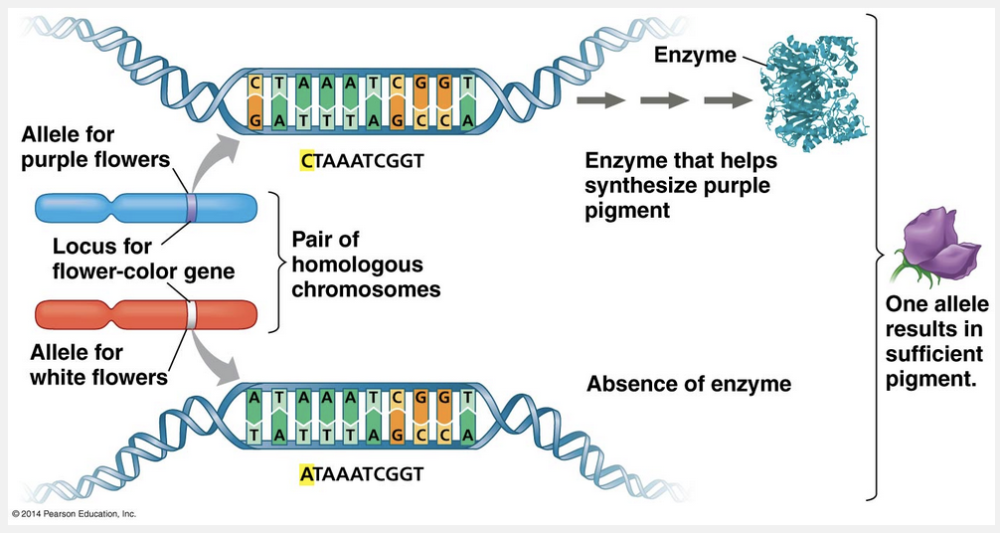
allele
Ex.
An alternative version of a gene is called an allele.
Alternative versions of genes account for variations in inherited characters. The gene for flower color in pea plants, for example, exists in two versions, one for purple flowers and the other for white flowers. These alternative versions are alleles. Today, we can also relate this concept to chromosomes and DNA. Each gene is a sequence of nucleotides at a specific place, or locus, along a particular chromosome. The DNA at that locus, however, can vary slightly in its nucleotide sequence. This variation in information content can affect the function of the encoded protein and thus the phenotype of the organism. The purple-flower allele and the white-flower allele are two possible DNA sequence variations at the flower-color locus on one of a pea plant’s chromosomes; one variation allows synthesis of purple pigment and the other variation does not.
“Character” is incorrect because a character is a heritable feature, such as flower color, that varies among individuals. “Generation” is incorrect because this term refers to the offspring that result after pollination and seed production. “Phenotype” is incorrect because this term refers to an organism’s appearance or observable traits. “Genotype” is incorrect because this term refers to an organism’s genetic makeup.
Fetal cells may be removed along with fluid from the womb by a process known as __________.
- amniocentesis
- karyotyping
- chorionic villus sampling
- sonogramming
- testcrossing
amniocentesis
Ex.
Fetal cells may be removed along with fluid from the womb by a process known as amniocentesis.
Suppose a couple expecting a child learns that they are both carriers of the Tay-Sachs allele. In the 14th–16th week of pregnancy, tests performed along with a technique called amniocentesis can determine whether the developing fetus has Tay-Sachs disease. In this procedure, a physician inserts a needle into the uterus and extracts about 10 mL of amniotic fluid, the liquid that bathes the fetus. Some genetic disorders can be detected from the presence of certain molecules in the amniotic fluid itself. Tests for other disorders, including Tay-Sachs disease, are performed on the DNA of cells cultured in the laboratory, descendants of fetal cells sloughed off into the amniotic fluid.
Karyotyping would not work because it is a process performed on fetal cells after amniocentesis. A testcross is a method for determining the genotype of an organism with a dominant phenotype. A sonogram is not invasive. CVS does not require taking amniotic fluid.
In a typical pea experiment, two true-breeding plants with distinct traits of a single character are called the __________, and the offspring are called the __________, which will always be __________.
- P (or parental) generation; F2 (or second filial) generation; true breeding
- F1 (or first filial) generation; F2 (or second filial) generation; true breeding
- P (or parental) generation; F1 (or first filial) generation; hybrid
- P (or parental) generation; F1 (or first filial) generation; true breeding
- F1 (or first filial) generation; F2 (or second filial) generation; hybrid
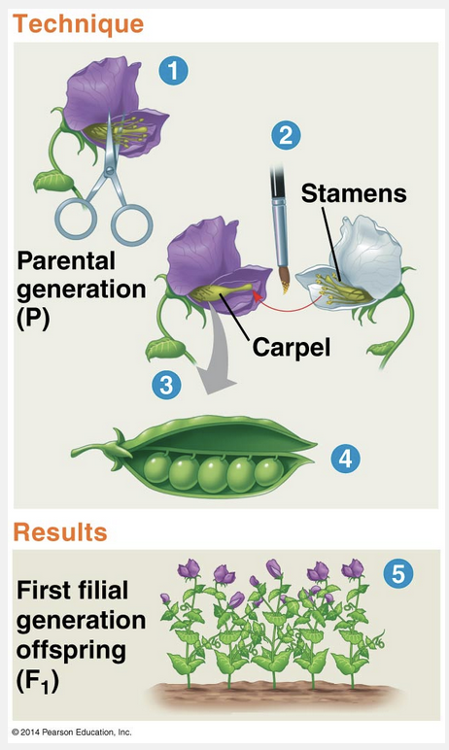
P (or parental) generation; F1 (or first filial) generation; hybrid
Ex.
In a typical pea experiment, two true-breeding plants with distinct traits of a single character are called the P (or parental) generation, and the offspring are called the F1 (or first filial) generation, which will always be hybrid.
In a typical breeding experiment, Mendel cross-pollinated two contrasting, true-breeding pea varieties—for example, purple-flowered plants and white-flowered plants. This mating, or crossing, of two true-breeding varieties is called hybridization. The true-breeding parents are referred to as the P generation (parental generation), and their hybrid offspring are the F1 generation (first filial generation; the word filial is from the Latin word for “son”).
“P (or parental) generation; F1 (or first filial) generation; true breeding” is incorrect because when two true-breeding plants with distinct traits of a single character are cross-pollinated, the F1 is always hybrid. “F1 (or first filial) generation; F2 (or second filial) generation; hybrid” is incorrect because F1 hybrids are the result of a mating experiment between two true-breeding plants with distinct traits of a single character, called the P (or parental) generation. “F1 (or first filial) generation; F2 (or second filial) generation; true breeding” is incorrect because F1 hybrids are the result of a mating experiment between two true-breeding plants with distinct traits of a single character, called the P (or parental) generation. “P (or parental) generation; F2 (or second filial) generation; true breeding” is incorrect because F1 hybrids are the result of a mating experiment between two true-breeding plants with distinct traits of a single character, called the P (or parental) generation and not the F2 (or second filial) generation.
A family tree that describes traits in families is called a __________.
- pedigree analysis
- Punnett square analysis
- standard deviation
- quantitative character
- qualitative character
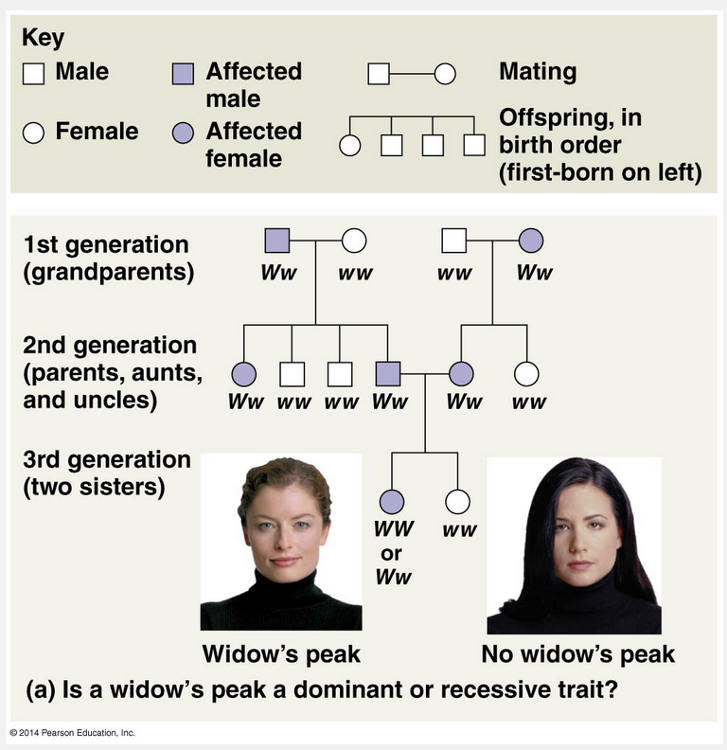
pedigree analysis
Ex.
A family tree that describes traits in families is called a pedigree analysis.
Because scientists are unable to manipulate the mating patterns of people, geneticists instead analyze the results of matings that have already occurred. They do so by collecting information about a family’s history for a particular trait and assembling this information into a family tree describing the traits of parents and children across the generations—the family pedigree. The figure gelow shows a three-generation pedigree that traces the occurrence of a pointed contour of the hairline on the forehead. This trait, called a widow’s peak, is due to a dominant allele, W . Because the widow’s peak allele is dominant, all individuals who lack a widow’s peak must be homozygous recessive ( ww ). The two grandparents with widow’s peaks must have the Ww genotype, since some of their offspring are homozygous recessive. The offspring in the second generation who do have widow’s peaks must also be heterozygous because they are the products of Ww × ww matings. The third generation in this pedigree consists of two sisters. The one who has a widow’s peak could be either homozygous ( WW ) or heterozygous ( Ww ), given what we know about the genotypes of her parents (both Ww ).
“Punnett square analysis” is incorrect because this is a diagram used in the study of inheritance to show the predicted genotype results of random fertilization in genetic crosses between individuals of known genotypes. “Quantitative character” is incorrect because in genetics, this is a heritable feature that varies continuously over a range rather than in an either-or fashion. “Qualitative character” is incorrect because this is not a term used in genetics. “Standard deviation” is incorrect because this is a measure of the variation found in a set of data points.
What kind of protection does the Genetic Information Nondiscrimination Act of 2008 provide the public with regard to the use of genetic information?
- The law mandates that people who undergo genetic testing are provided professional instruction so that they can make informed family decisions based on their test results.
- The law prohibits the use of genetic test information to deny insurance coverage or employment to individuals.
- The law mandates that all expecting mothers must undergo fetal testing for genetic disorders regardless of their demographic status.
- The law guarantees that access to genetic counseling cannot be denied to U.S. citizens based on their race, sex, age, religious beliefs, or sexual orientation.
The law prohibits the use of genetic test information to deny insurance coverage or employment to individuals.
Ex.
The Genetic Information Nondiscrimination Act of 2008 provides the public protection with regards to the use of genetic information. The law prohibits the use of genetic test information to deny insurance coverage or employment to individuals.
Tests for identifying carriers enable people with family histories of genetic disorders to make informed decisions about having children, but raise other issues. Could carriers be denied health or life insurance or lose the jobs providing those benefits, even though they themselves are healthy? The Genetic Information Nondiscrimination Act, signed into law in the United States in 2008, allays these concerns by prohibiting discrimination in employment or insurance coverage based on genetic test results.
The law provides protection from discrimination but not based on their race, sex, age, religious beliefs, or sexual orientation. The law does not mandate people to be tested but provides protection for those individuals who voluntarily undergo genetic testing. The law does not compel individuals to undergo any type of testing, fetal or not, but does provide protection for how the results of genetic testing can be used.
In Labrador retrievers, a dog that has the genotype BBee , where BB produces black-pigmented fur and ee produces yellow-pigmented fur, would have __________ fur and would exhibit __________.
- yellow; epistasis
- black; dominance
- yellow; incomplete dominance
- brown; codominance
- brown; epistasis
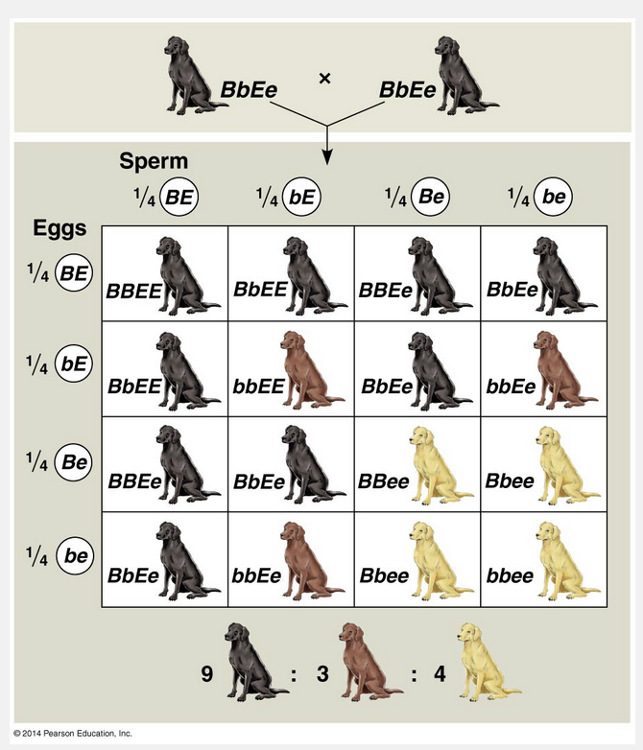
yellow; epistasis
Ex.
In Labrador retrievers, a dog that has the genotype BBee , where BB produces black-pigmented fur and ee produces yellow-pigmented fur, would have yellow fur and would exhibit epistasis .
In epistasis (from the Greek for “standing upon”), the phenotypic expression of a gene at one locus alters the expression of a gene at a second locus. An example will help clarify this concept: In Labrador retrievers (commonly called “Labs”), black coat color is dominant to brown coat color. Let’s designate B and b as the two alleles for this character. For a Lab to have brown fur, its genotype must be bb ; these dogs are called chocolate Labs. But there is more to the story. A second gene determines whether or not pigment will be deposited in the fur. The dominant allele, symbolized by E , results in the deposition of either black or brown pigment, depending on the genotype at the first locus. But if the Lab is homozygous recessive for the second locus ( ee ), then the coat is yellow, regardless of the genotype at the black/brown locus (so-called golden Labs). In this case, the gene for pigment deposition ( E / e ) is said to be epistatic to the gene that codes for black or brown pigment ( B / b ). What happens if we mate black Labs that are heterozygous for both genes ( BbEe )? Although the two genes affect the same phenotypic character (coat color), they follow the law of independent assortment. Thus, our breeding experiment would represent an F 1 dihybrid cross like those that produced a 9:3:3:1 ratio in Mendel’s experiments. We can use a Punnett square to represent the genotypes of the F 2 offspring. As a result of epistasis, the phenotypic ratio among the F 2 offspring would be 9 black to 3 chocolate to 4 golden Labs. Other types of epistatic interactions produce different ratios, but all are modified versions of 9:3:3:1.
“Black; dominance,” “brown; codominance,” and “brown; epistasis” are incorrect because if the Lab is homozygous recessive for the second locus ( ee ), then the coat would be yellow, regardless of the genotype at the black/brown locus; and the ( E / e ) is said to be epistatic to the gene that codes for black or brown pigment ( B / b ). “Yellow; incomplete dominance” is incorrect because the yellow color results because the ( E / e ) is said to be epistatic to the gene that codes for black or brown pigment ( B / b ).
The effect of the environment on a phenotype is referred to as __________.
- multifactorial
- multiple allelic
- pleiotropic
- polygenetic
- epistatic

multifactorial
Ex.
The effect of the environment on a phenotype is referred to as multifactorial .
Another departure from Mendelian genetics arises when the phenotype for a character depends on environment as well as genotype. A single tree, locked into its inherited genotype, has leaves that vary in size, shape, and greenness, depending on their exposure to wind and sun. For humans, nutrition influences height, exercise alters build, sun-tanning darkens the skin, and experience improves performance on intelligence tests. Even identical twins, who are genetic equals, accumulate phenotypic differences as a result of their unique experiences. Whether human characters are influenced more by genes or by the environment—in everyday terms, nature versus nurture—is a debate that we will not attempt to settle here. We can say, however, that a genotype generally is not associated with a rigidly defined phenotype but, rather, with a range of phenotypic possibilities due to environmental influences. For some characters, such as the ABO blood group system, the phenotypic range has no breadth whatsoever; that is, a given genotype mandates a very specific phenotype. Other characters, such as a person’s blood count of red and white cells, vary quite a bit, depending on such factors as the altitude, the customary level of physical activity, and the presence of infectious agents. Generally, the phenotypic range is broadest for polygenic characters. Environment contributes to the quantitative nature of these characters, as we have seen in the continuous variation of skin color. Geneticists refer to such characters as multifactorial, meaning that many factors, both genetic and environmental, collectively influence phenotype.
“Pleiotropic” is incorrect because pleiotropy is the ability of a single gene to have multiple effects on the phenotype of an individual. “Epistatic” is incorrect because epistasis is a type of gene interaction in which the phenotype expression of one gene alters that of another, independently inherited gene. “Polygenetic” is incorrect because this usually indicates polygenic inheritance, an additive effect of two or more genes on a single phenotypic character. “Multiple allelic” is incorrect because this requires more than two alleles for a single gene.
If the two traits that Mendel looked at in his dihybrid cross of smooth yellow peas with wrinkled green peas had been controlled by genes that were located near each other on the same chromosome, then the F2 generation __________.
- would have contained no individuals that were heterozygous at both loci
- would have contained four phenotypes in a 9:3:3:1 ratio
- would have contained only individuals that were heterozygous at both loci
- None of the listed responses is correct.
- would have deviated from the 9:3:3:1 phenotypic ratio that is predicted by the law of independent assortment
would have deviated from the 9:3:3:1 phenotypic ratio that is predicted by the law of independent assortment
Ex.
If the two traits that Mendel looked at in his dihybrid cross of smooth yellow peas with wrinkled green peas had been controlled by genes that were located near each other on the same chromosome, then the F2 generation would have deviated from the 9:3:3:1 phenotypic ratio that is predicted by the law of independent assortment.
Mendel identified his second law of inheritance by following two characters at the same time, such as seed color and seed shape. Seeds (peas) may be either yellow or green. They also may be either round (smooth) or wrinkled. From single character crosses, Mendel knew that the allele for yellow seeds is dominant (Y), and the allele for green seeds is recessive (y). For the seed-shape character, the allele for round is dominant (R), and the allele for wrinkled is recessive (r). Imagine crossing two true-breeding pea varieties that differ in both of these characters—a cross between a plant with yellow round seeds (YYRR) and a plant with green-wrinkled seeds (yyrr). The F1 plants will be dihybrids, individuals heterozygous for the two characters being followed in the cross (YyRr). This type of cross, called a dihybrid cross, is a cross between F1 dihybrids, and can determine whether the different traits are inherited together or independently.
The F1 plants, of genotype YyRr, exhibit both dominant phenotypes, yellow seeds with round shapes, no matter which hypothesis is correct. The key step in the experiment is to see what happens when F1 plants self-pollinate and produce F2 offspring. If the hybrids must transmit their alleles in the same combinations in which the alleles were inherited from the P generation, then the F1 hybrids will produce only two classes of gametes: YR and yr. This “dependent assortment” hypothesis predicts that the phenotypic ratio of the F2 generation will be 3:1, just as in a monohybrid cross. If the two characters are located on the same chromosome, they will not segregate independently and would not produce the 9:3:3:1 ratio that Mendel actually observed. If four phenotypes were observed in the F2 in a 9:3:3:1 ratio, then the genes would have segregated independently of each other.
Mendel’s law of segregation states that __________.
- the two alleles for a heritable character segregate (separate from each other) during gamete formation and end up in different gametes
- the two alleles for a heritable character do not segregate during gamete formation and end up in the same gametes
- only true-breeding plants can be bred with true-breeding plants
- The law of segregation does not apply to pea plants.
- non-true-breeding plants can be bred with non-true-breeding plants
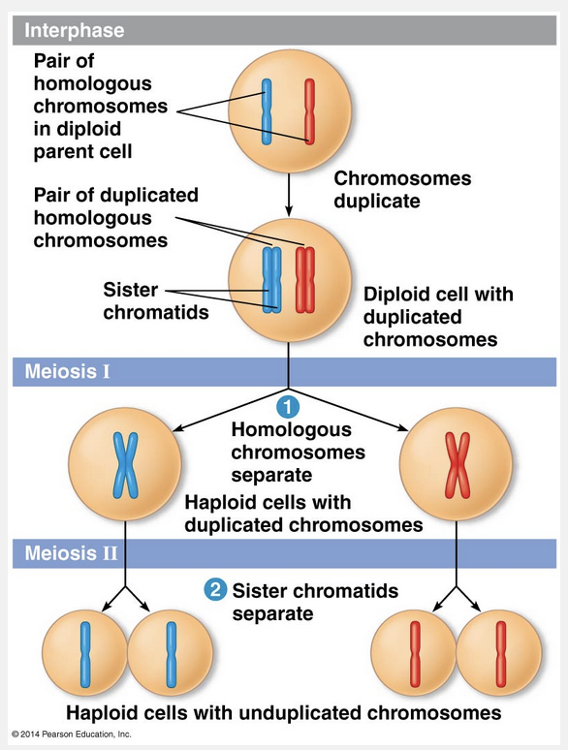
the two alleles for a heritable character segregate (separate from each other) during gamete formation and end up in different gametes
Ex.
Mendel’s law of segregation states that the two alleles for a heritable character segregate (separate from each other) during gamete formation and end up in different gametes. Thus, an egg or a sperm gets only one of the two alleles that are present in the somatic cells of the organism that make up the gamete.
In terms of chromosomes, this segregation corresponds to the distribution of the two members of a pair of homologous chromosomes to different gametes in meiosis. Note that if an organism has identical alleles for a particular character—that is, the organism is true-breeding for that character—then that allele is present in all gametes. But if different alleles are present, as in the F1 hybrids, then 50% of the gametes receive the dominant allele and 50% receive the recessive allele.
“The two alleles for a heritable character do not segregate during gamete formation and end up in the same gametes” is incorrect because the alleles separate during gamete formation.
“Only true-breeding plants can be bred with true-breeding plants” and “non-true-breeding plants can be bred with non-true-breeding plants” are incorrect because this has nothing to do with alleles, gamete formation, or Mendel’s law of segregation. “The law of segregation does not apply to pea plants” is incorrect because in all sexually reproducing organisms, the law of segregation states that the two alleles for a heritable character segregate during gamete formation and end up in different gametes.
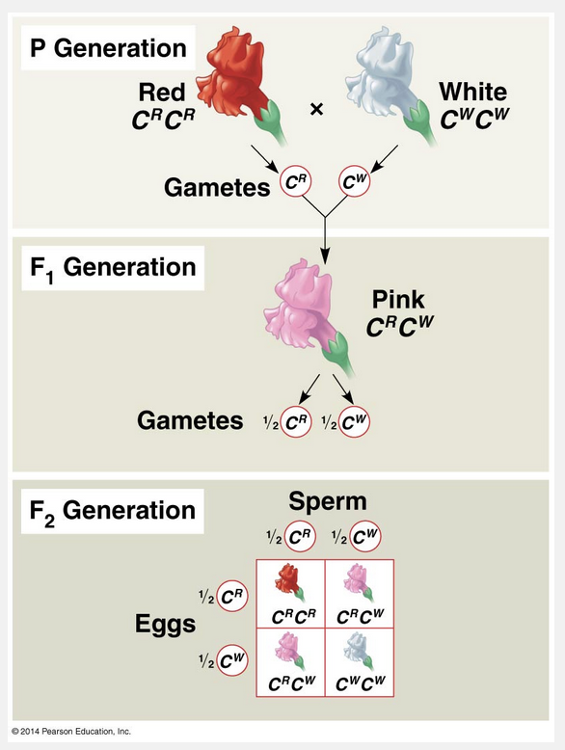
In incomplete dominance, the offspring __________.
- will resemble the dominant type 75% of the time
- will resemble the recessive type 25% of the time
- will resemble the recessive type 50% of the time
- will resemble the dominant type 50% of the time
- will have an appearance that’s intermediate between those of the two parental types
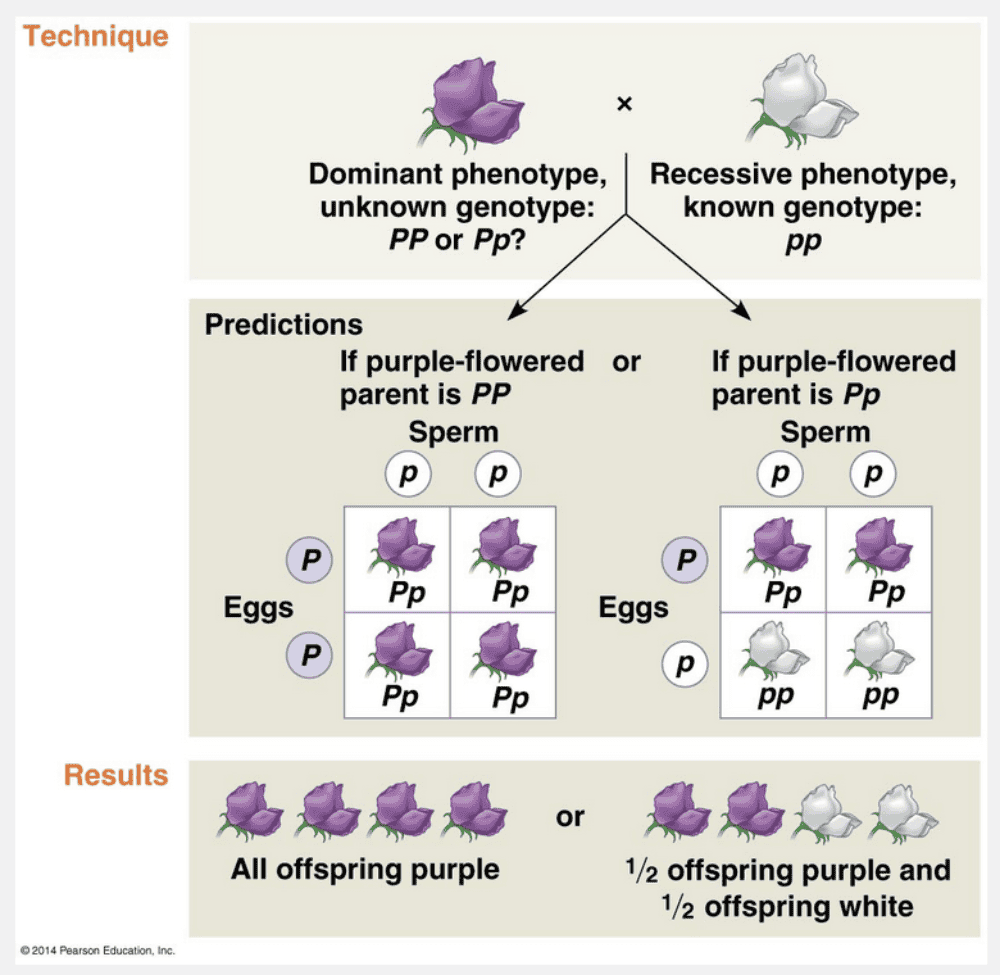
will have an appearance that’s intermediate between those of the two parental types
Ex.
In incomplete dominance, the offspring will have an appearance that’s intermediate between those of the two parental types.
For some genes, neither allele is completely dominant, and the F1 hybrids have a phenotype somewhere between those of the two parental varieties. This phenomenon, called incomplete dominance, is seen when red snapdragons are crossed with white snapdragons:
All the F1 hybrids have pink flowers. This third, intermediate phenotype results from flowers of the heterozygotes having less red pigment than the red homozygotes.
(This is unlike the case of Mendel’s pea plants, where the Pp heterozygotes make enough pigment for the flowers to be purple, which is indistinguishable from those of PP plants.)
“Will resemble the recessive type 50% of the time,” “will resemble the dominant type 50% of the time,” “will resemble the recessive type 25% of the time,” and “will resemble the dominant type 75% of the time” are incorrect because in incomplete dominance, the offspring will have an appearance that’s intermediate between those of their parents.
A man who can roll his tongue and a woman who cannot roll her tongue have a son who can roll his tongue (R = can roll tongue; r = can't roll tongue). The son is curious about whether his father is homozygous or heterozygous for the tongue-rolling trait. Which of the following facts would allow him to know?
- The son submits his own blood sample to a local genotyping lab, and they establish that he is heterozygous for the trait.
- The son's sister is a tongue roller.
- His father's mother cannot roll her tongue.
- The son's own daughter cannot roll her tongue.
- His paternal grandfather and his paternal grandmother can both roll their tongues.
His father's mother cannot roll her tongue.
Ex.
A man who can roll his tongue and a woman who cannot roll her tongue have a son who can roll his tongue (R = can roll tongue; r = can't roll tongue). The son is curious about whether his father is homozygous or heterozygous for the tongue-rolling trait. The following fact would allow him to know: His father's mother cannot roll her tongue.
Unable to manipulate the mating patterns of people, geneticists must analyze the results of matings that have already occurred. They do so by collecting information about a family’s history for a particular trait and assembling this information into a family tree describing the traits of parents and children across the generations—the family pedigree. By examining phenotypes of the son’s grandparents, he can determine information regarding his parents’ genotypes. If his father's mother cannot roll her tongue, then his father must be heterozygous because this trait is recessive. If the father’s mother cannot roll her tongue, the father had to have inherited a recessive allele from her.
Because tongue-rolling ability is dominant, knowing that his paternal grandfather and his paternal grandmother can both roll their tongues would not tell you whether his father is homozygous or heterozygous. His sister must have inherited the tongue-rolling allele from her father, but this would not help determine whether the father is homozygous or heterozygous for the trait.
Knowing that the son's own daughter cannot roll her tongue would tell him that he himself is heterozygous, but would say nothing about his father. It was already clear that he was heterozygous, because his mother is homozygous recessive.
Besides the fact that pea plants have a short generation time, the key to Mendel’s successful plant-breeding experiments was that pea plants usually __________.
- reproduce by making clones
- animal-pollinate
- wind-pollinate
- cross-pollinate
- self-pollinate
self-pollinate
Ex.
Besides the fact that pea plants have a short generation time, the key to Mendel’s successful plant-breeding experiments was that pea plants usually self-pollinate.
In addition to having many varieties, peas have a short generation time and a large number of offspring from each mating. Furthermore, Mendel could strictly control mating between plants. Each pea flower has both pollen-producing organs (stamens) and an egg-bearing organ (carpel). In nature, pea plants usually self-fertilize: Pollen grains from the stamens land on the carpel of the same flower, and sperm released from the pollen grains fertilize eggs present in the carpel. To achieve cross-pollination of two plants, Mendel removed the immature stamens of a plant before they produced pollen and then dusted pollen from another plant onto the altered flowers. Each resulting zygote then developed into a plant embryo encased in a seed (pea). Mendel could thus always be sure of the parentage of new seeds.
“Cross-pollinate,” “wind-pollinate,” and “animal-pollinate” are incorrect because pea plants usually self-pollinate. “Reproduce by making clones” is incorrect because the seed called the pea results from the fertilization of eggs by pollen grains.
Human ABO groups are best described as an example of __________.
- multiple alleles
- autosomal dominant alleles
- a pleiotropic effect
- codominant alleles
- Mendelian dominant and recessive alleles
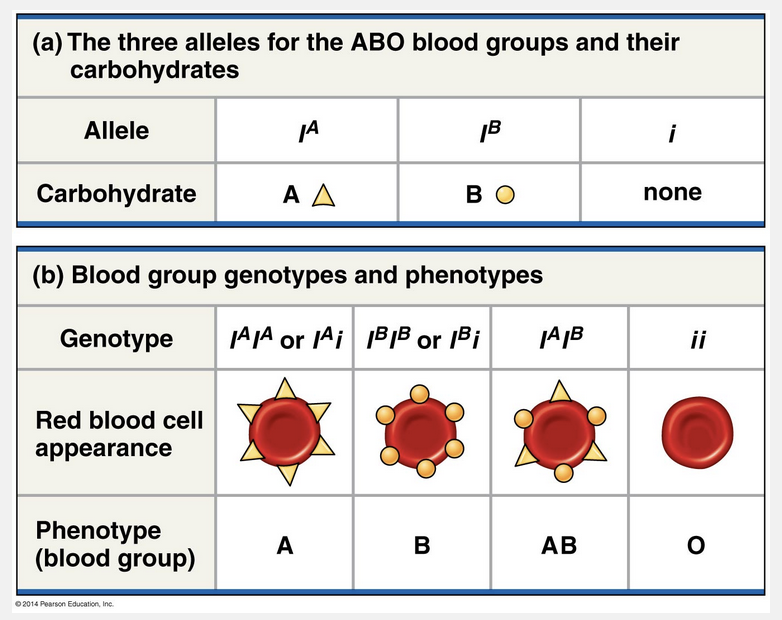
multiple alleles
Ex.
Human ABO groups are best described as an example of multiple alleles.
Only two alleles exist for the pea characters that Mendel studied, but most genes exist in more than two allelic forms. The ABO blood groups in humans, for instance, are determined by three alleles of a single gene: IA, IB, and i. A person’s blood group may be one of four types: A, B, AB, or O. These letters refer to two carbohydrates—A and B—that may be found on the surface of red blood cells. A person’s blood cells may have carbohydrate A (type A blood), carbohydrate B (type B), both (type AB), or neither (type O). Matching compatible blood groups is critical for safe blood transfusions.
“Codominant alleles” is incorrect because the ABO system has three alleles, and only the individual with AB blood type would have the codominant phenotype. “Mendelian dominant and recessive alleles” is incorrect because the pea characters that Mendel studied had only two alleles. “Autosomal dominant alleles” is incorrect because this is the allele that is fully expressed in the phenotype of a heterozygote. “A pleiotropic effect” is incorrect because pleiotropy is the ability of a single gene to have multiple effects on the phenotype of an individual.
In humans, height and skin color have continuous variation in the population because of __________.
- codominance
- epistasis
- polygenic inheritance
- multiple alleles
- incomplete dominance
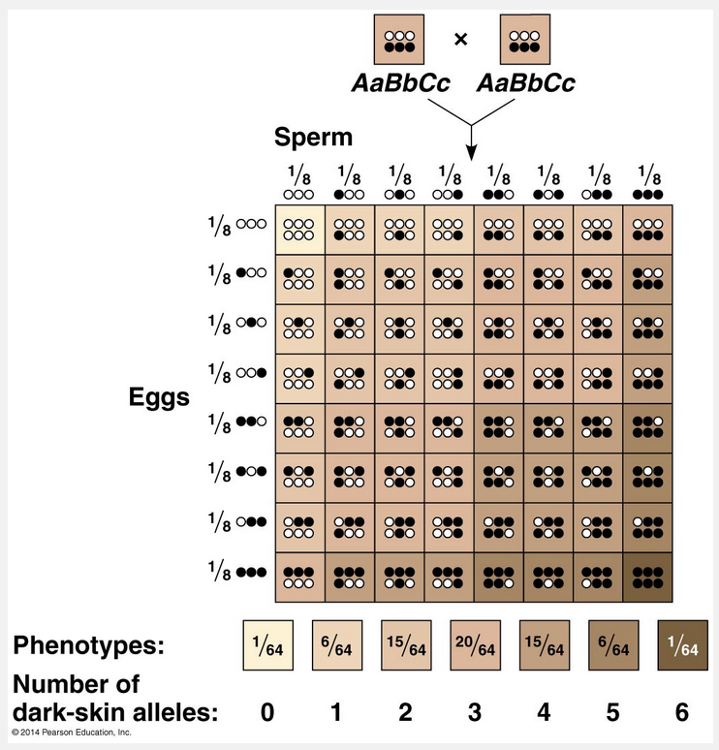
polygenic inheritance
Ex.
In humans, height and skin color have continuous variation in the population because of polygenic inheritance .
Mendel studied characters that could be classified on an either-or basis, such as purple- versus white-flower color. But many characters, such as human skin color and height, are not one of two discrete characters but instead vary in the population in gradations along a continuum. These are called quantitative characters. Quantitative variation usually indicates polygenic inheritance, an additive effect of two or more genes on a single phenotypic character. (In a way, this is the converse of pleiotropy, where a single gene affects several phenotypic characters.) Height is a good example of polygenic inheritance: A recent study using genomic methods identified at least 180 genes that affect height. Skin pigmentation in humans is also controlled by many separately inherited genes. Here, we’ll simplify the story in order to explain the concept of polygenic inheritance. Let’s consider three genes, with a dark-skin allele for each gene ( A , B , or C ) contributing one “unit” of darkness (also a simplification) to the phenotype and being incompletely dominant to the other allele ( a , b , or c ). In our model, an AABBCC person would be very dark, whereas an a abbcc individual would be very light. An AaBbCc person would have skin of an intermediate shade. Because the alleles have a cumulative effect, the genotypes AaBbCc and AABbcc would result in the same genetic contribution (three units) to skin darkness. There are seven skin color phenotypes that could result from a mating between AaBbCc heterozygotes. In a large number of such matings, the majority of offspring would be expected to have intermediate phenotypes (skin color in the middle range).
“Epistasis” is incorrect because epistasis is a type of gene interaction in which the phenotype expression of one gene alters that of another, independently inherited gene. “Codominance” is incorrect because both alleles would be present. “Multiple alleles” is incorrect because this requires more than two alleles for a single gene. “Incomplete dominance” is incorrect because this would produce offspring with phenotypes intermediate between those of the two parental types.
Huntington's disease is an example of a genetic disorder caused by __________.
- homozygous recessive alleles
- a lethal dominant allele that afflicts an individual later in life
- multiple alleles
- a late-acting recessive allele
- a nonlethal dominant allele
a lethal dominant allele that afflicts an individual later in life
Ex.
Huntington's disease is an example of a genetic disorder caused by a lethal dominant allele that afflicts an individual later in life.
The timing of the onset of a disease significantly affects its inheritance. A lethal dominant allele is able to be passed on if it causes death at a relatively advanced age. By the time symptoms are evident, the individual with the allele may have already transmitted it to his or her children. For example, Huntington’s disease, a degenerative disease of the nervous system, is caused by a lethal dominant allele that has no obvious phenotypic effect until the individual is about 35 to 45 years old. Once the deterioration of the nervous system begins, it is irreversible and inevitably fatal.
As with other dominant traits, a child born to a parent with the Huntington’s disease allele has a 50% chance of inheriting the allele and the disorder. The disease is late-acting, but the allele is dominant. A single allele causes the disease.